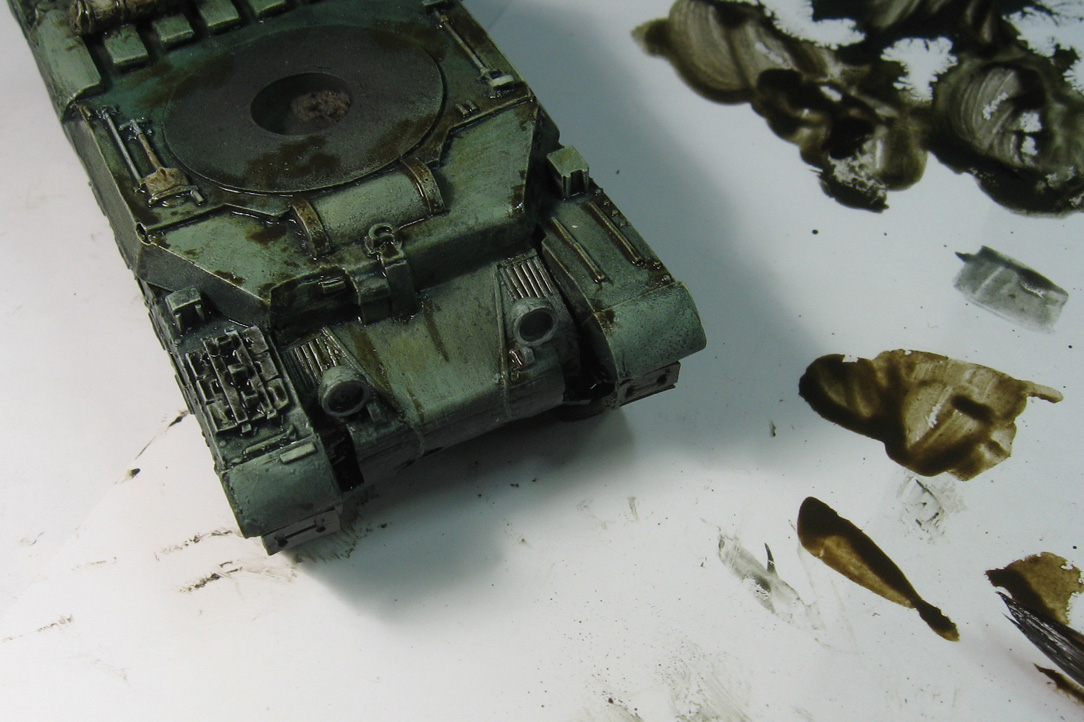Continuing the experimentation with the AMMO oil based products, I moved on to the vertical surfaces and some of the darker washes. Since these layers were not going to be drying anywhere near as rapidly as my normal acrylic versions, it meant that I could continually blend one layer into the next.
Again, the usual approach to these materials is to cleanly layer one on top of the next after the original layer is dry. I kept forging ahead to see what kind of blending could be done :-)
These new layers needed to be darker, so I used more of the wash products. Unlike the Filters and Panel washes, these are the thickest and most heavily pigmented of the washes. You will see that play out over the next few images.
Not only would these layers be darker... they would also be allowed to accumulate or be less blended to create staining. This is visible on some of the horizontal panels.
As for the sides of the hull, my flatter, dry brushes were used to swipe the wash colors downward, creating some nice weathering marks.
I did something similar on the sides of the turret. Again, it was a great advantage to be able to position some paint, and then have so much time to manipulate it! I loved the option of wiping something away if I didn't like the result.
As I have mentioned before, this far longer drying time will make it much easier for me to paint multiple vehicles at once. The acrylic approach is difficult enough with just one at a time.
At this stage, I have been able to work in the darker shades all across the vehicle, which will set up the subsequent, dedicated weathering effects.
I have some of the rust and grime colors, so those were the first paints that I tested. Having done rust effects with endless combinations of acrylic paints (and even weathering powders), I liked the options the oil based products presented.
The increased capillary action of the oil based pigments proved very useful in getting rust colors deep into recesses, which is exactly where they would accumulate. In the past, I would use a mixture of powders and sealer fluid to get this action. Now it's all in one handy jar!
The rust is placed on other surfaces. You can see a few rust streaks emerging from paint chips in some areas. The streaks are also easier to randomize, since I can go back in and rework the shape and length of each streak.
The more rapid drying paints force me to get the streaks exactly the right shape with far less ability to manipulate later.
This is repeated across the vertical surfaces too. Note that I am starting out with the darker rust tone. Later I will work in a bit of the lighter rust color.
This overview shows you how I have been mixing multiple colors and paint types on the palette. Just like my regular acrylics, I like to mix the colors that I need. A big advantage in this approach is color unity, as only a few basic colors are used to create a wider range of shades and tones.
Everything becomes more cohesive as a result.
If you look at the palette off to the right, you can clearly see that the streaking rust has been mixed with the panel washes. This created a whole new shade of color, which was used on the darker areas of the stowage.
Some rust was added to the top of the turret and the extra tank treads as well.
Here's where things REALLY get interesting! I wanted to see if I could get some semi opaque lighter colors to work with, just like I do with my acrylics. This is normally done by mixing my glaze materials with 'regular' paint.
I will have to take a few very different materials and combine them to get that light middle tone. I'm taking the very opaque mud effects pigment and mixing that in with panel line washes, etc. You can see that I can create muted green colors, light tans, and even flesh tones!
I also wanted to try out some lighter rain streaks on the darker sides of the hull. The first step was to place a few dots of that light mud pigment mixed with a touch of panel wash to make it flow.
Using one of my flat dry brushes, this was pulled and stretched downwards to make the streaks.
The third episode will show some more of the new paints being mixed and applied for the first time, including the grease and engine oil colors. Some dry pigments will also be added, and I will try to mix static grass and even leaves into the heavy mud pigments!
Stay tuned...















